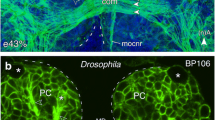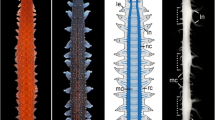Abstract
Topographic anatomy of ascending (AN) and descending (DN) neurons of the supraesophageal and thoracic ganglia in the nervous system of winged insects (Pterygota), representatives of the infraclasses Palaeoptera (Odonata, Aeschna grandis, dragonfly) and Neoptera (Blattoptera, Periplaneta americana, cockroach), was studied. These insects differ in ecological niches, lifestyles, sets of behavioral complexes, levels of locomotor system development, evolutionary age and systematic position. Cell bodies and processes of ANs and DNs were stained with nickel chloride (NiCl2), and their topography was studied on total preparations of the supraesophageal and thoracic ganglia. Unlike cockroaches, the dragonfly protocerebrum was found to contain DNs sending their processes to ocelli. Dragonfly DN processes exhibit a specific branching pattern in thoracic ganglia, with collaterals coming off both ipsi- and contralaterally. In cockroaches, collaterals of DN processes come off ipsilaterally. The AN cell bodies in dragonfly meso- and metathoracic ganglia lie both ipsi- and contralaterally relative to the ascending process, whereas in cockroaches most of the AN cell bodies in the same ganglia are located contralaterally. Substantial differences in the distrubution of DNs and ANs in insects with different manners of locomotion appear to reflect different degrees of control the supraesophageal ganglion exerts over the activity of segmental centers. This does not seem to be related to the evolutionary age of insects or their systematic position. Probably, different degrees of control over locomotion depend on the way of food acquisition: catching prey in the air in “paleopterous” dragonflies versus maneuverable walking or running over a solid substrate in “neopterous” cockroaches.
Similar content being viewed by others
References
Staudacher, E. and Schildberger, K., Gating of sensory responses of descending brain neurons during walking in crickets, J. Exp. Biol., 1998, vol. 201, pp. 559–572.
Buschges, A., Sensory control and organization of neural networks mediating coordination of multisegmental organs for locomotion, J. Neurophysiol., 2005, vol. 93, pp. 1127–1135.
Fuchs, E., Holmes, P., David, I., and Ayali, A., Proprioceptive feedback reinforces centrally generated stepping patterns in the cockroach, J. Exp. Biol., 2012, vol. 215, pp. 1884–1891.
Ache, J.M., Haupt, S.S., and Durr, V., A direct descending pathway informing locomotor networks about tactile sensor movement, J. Neurosci., 2015, vol. 35 (9), pp. 4081–4091.
Staudacher, E., Distribution and morphology of descending brain neurons in the cricket Gryllus bimaculatus, Cell Tiss. Res., 1998, vol. 294, pp. 187–202.
Okada, R., Sakura, M., and Mizunami, M., Distribution of dendrites of descending neurons and its implications for the basic organization of the cockroach brain, J. Comp. Neurol., 2003, vol. 458, pp. 158–174.
Burdohan, J.A. and Comer, C.M., Cellular organization of an antennal mechanosensory pathway in the cockroach, Periplaneta Americana, J. Neurosci., 1996, vol. 16, pp. 5830–5843.
Staudacher, E. and Schildberger, K., Gating of sensory responses of descending brain neurons during walking in crickets, J. Exp. Biol., 1998, vol. 201, pp. 559–572.
Staudacher, E.M., Sensory responses of descending brain neurons in the walking cricket,Gryllus bimaculatus, J. Comp. Physiol. A, 2001, vol. 187, pp. 1–17.
Kien, J., The initiation and maintenance of walking in the locust: an alternative to the command concept, Proc. Roy. Soc. Lond. Ser. B, 1983, vol. 219, pp. 137–174.
Hedwig, B., Control of grasshopper stridulation by descending brain neurons, Verh. Dtsch. Zool. Ges., 1995, vol. 88, pp. 181–190.
Simmons, P., Connexions between a movementdetecting visual interneurone and flight motoneurones of a locust, J. Exp. Biol., 1980, vol. 86, pp. 87–97.
Reichert, H., Rowell, C.H.F., and Griss, C., Course correction circuitry transkates feature detection into behavioural action in locusts, Nature, 1985, vol. 315, pp. 142–144.
Hedwig, B. and Heinrich, R., Identified descending brain neurons control different stridulatory motor patterns in an acridid grasshopper, J. Comp. Physiol. A, 1997, vol. 180, pp. 285–294.
Hedwig, B., Control of cricket stridulation by a command neuron: efficacy depends on the behavioral state, J. Neurophysiol., 2000, vol. 83, pp. 712–722.
Bohm, H. and Schildberger, K., Brain neurons involved in the control of walking in the cricket Gryllus bimaculatus, J. Exp. Biol., 1992, vol. 166, pp. 113–130.
Heindrich, R., Impact of descending brain neurons on the control of stridulation, walking, and flight in Orthoptera, Microsc. Res. Tech., 2002, vol. 56, pp. 292–301.
Rowell, C.H.F., Descending interneurones of the locust reporting deviation from flight course: what is their role in steering? J. Exp. Biol., 1989, vol. 146, pp. 177–194.
Hensler, K. and Rowell, C.H.F., Control of optomotor responses by descending deviation detector neurones in intact flying locusts, J. Exp. Biol., 1990, vol. 149, pp. 191–205.
Nebeling, B., Morphology and physiology of auditory and vibratory ascending interneurones in bushcrickets, J. Exp. Zool., 2000, vol. 286, pp. 219–230.
Zorovic, M. and Hedwig, B., Processing of species-specific auditory patterns in the cricket brain by ascending, local, and descending neurons during standing and walking, J. Neurophysiol., 2011, vol. 105 (5), pp. 2181–2194.
Berry, R., van Kleef, J., and Stange, G., The mapping of visual space by dragonfly lateral ocelli, J. Comp. Physiol. A, 2007, vol. 193, pp. 495–513.
Berry, R., Stange, G., Olberg, R., and van Kleef, J., The mapping of visual space by identified large second-order neurons in the dragonfly median ocellus, J. Comp. Physiol. A, 2006, vol. 192, pp. 1105–1123.
Wilson, M., The functional organisation of locust ocelli, J. Comp. Physiol. A, 1978, vol. 124, pp. 297–316.
Stange, G., The ocellar component of flight equilibrium control in dragonflies, J. Comp. Physiol. A, 1981, vol. 141, pp. 335–347.
Stange, G., Stowe, S., Chahl, J.S., and Massaro, A., Anistropic imaging in the dragonfly median ocellus: a matched filter for horizon detection, J. Comp. Physiol. A, 2002, vol. 188, pp. 455–467.
Milde, J. and Homberg, U., Ocellar interneurons in the honeybee: characteristics of spiking L-neurons, J. Comp. Physiol. A, 1984, vol. 155, pp. 151–160.
Williams, J.L.D., Anatomical studies of the insect central nervous system: a ground-plan of the midbrain and an introduction to the central complex in the locust Schistocerca gregaria (Orthoptera), J. Zool., 1975, vol. 176, pp. 67–86.
Boyan, G.S. and Williams, J.L.D., Descending interneurons in the brain of the cricket, Naturwiss., 1981, vol. 67, pp. 486–487.
Brodfuehrer, P.D. and Hoy, R.R., Ultrasound sensitive neurons in the cricket brain, J. Comp. Physiol. A, 1990, vol. 166, pp. 651–662.
Olberg, R.M., Identified target-selective visual interneurons descending from the dragonfly brain, J. Comp. Physiol. A, 1986, vol. 159, pp. 827–840.
Gonzalez-Bellido, P.T, Peng, H., Yang, J., Georgopoulos, A.P., and Olberg, R.M., Eight pairs of descending visual neurons in the dragonfly give wing motor centers accurate population vector of prey direction, Proc. Natl. Acad. Sci., 2013, vol. 110, pp. 696–701.
Olberg, R.M., Object- and self-movement detectors in the ventral nerve cord of the dragonfly, J. Comp. Physiol. A, 1981, vol. 141, pp. 327–334.
Strausfeld, N.J. and Gronenberg, W., Descending neurons supplying the neck and flight motor of Diptera: organization and neuroanatomical relationships with visual pathways, J. Comp. Neurol. A, 1990, vol. 302, pp. 954–972.
Buschges, A., Sensory control and organization of neural networks mediating coordination of multisegmental organs for locomotion, J. Neurophysiol., 2005, vol. 93, pp. 1127–1135.
Camhi, J.M., Escape behavior in the cockroach: distributed neural processing, Experientia, 1988, vol. 44, pp. 401–408.
Ritzmann, R.E., The neural organization of cockroach escape and its role in context-dependent orientation, Biological Neural Networks in Invertebrate Neuroethology and Robotics, Beer, R.D., Ritzmann, R.E., and McKenna, T., Eds., Boston, 1993, pp. 113–137.
Author information
Authors and Affiliations
Corresponding author
Additional information
Original Russian Text © I.Yu. Severina, I.L. Isavnina, A.N. Knyazev, 2016, published in Zhurnal Evolyutsionnoi Biokhimii i Fiziologii, 2016, Vol. 52, No. 5, pp. 362—370.
Rights and permissions
About this article
Cite this article
Severina, I.Y., Isavnina, I.L. & Knyazev, A.N. Topographic anatomy of ascending and descending neurons of the supraesophageal, meso- and metathoracic ganglia in paleo- and neopterous insects. J Evol Biochem Phys 52, 397–406 (2016). https://doi.org/10.1134/S0022093016050082
Received:
Published:
Issue Date:
DOI: https://doi.org/10.1134/S0022093016050082




